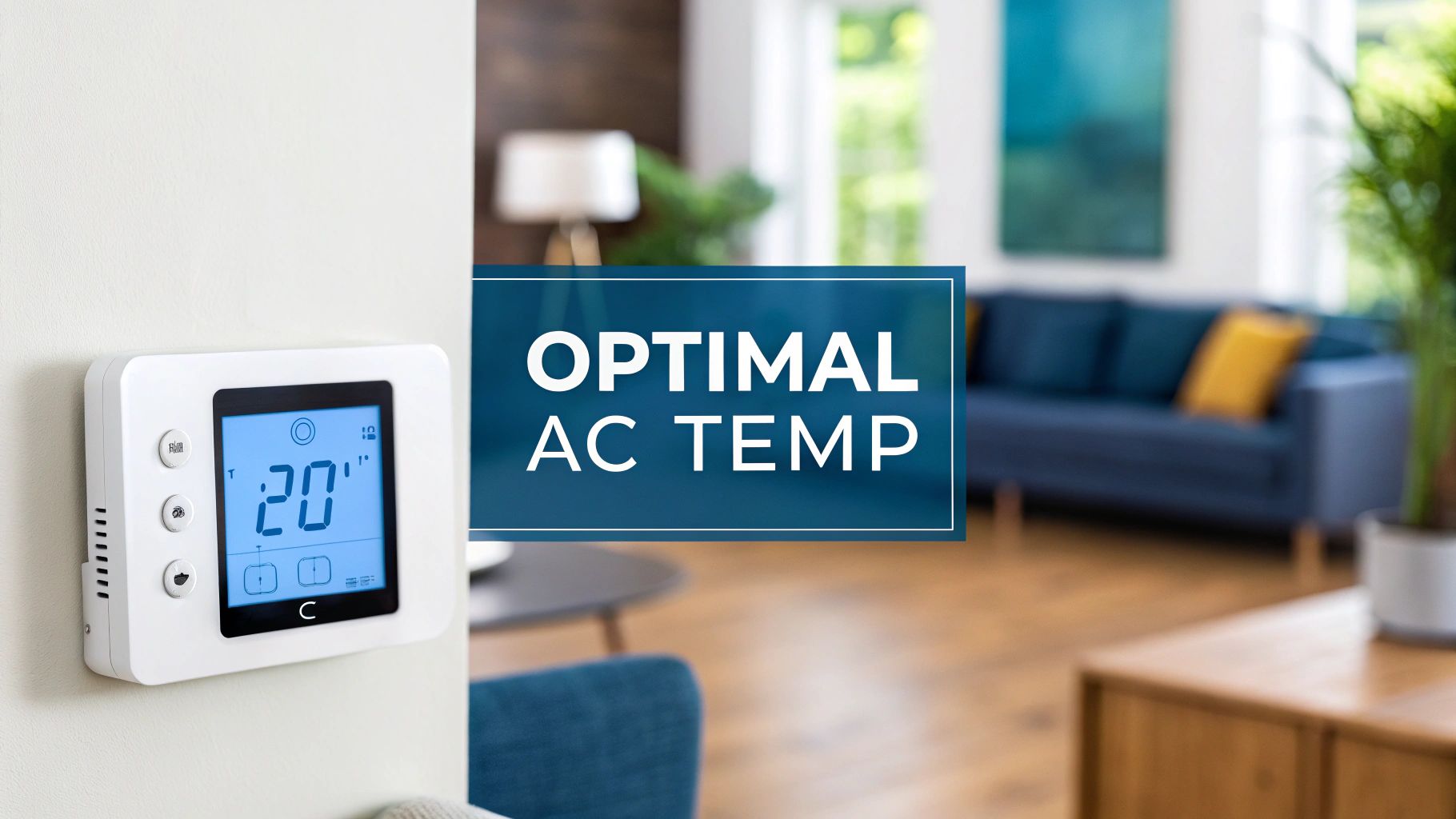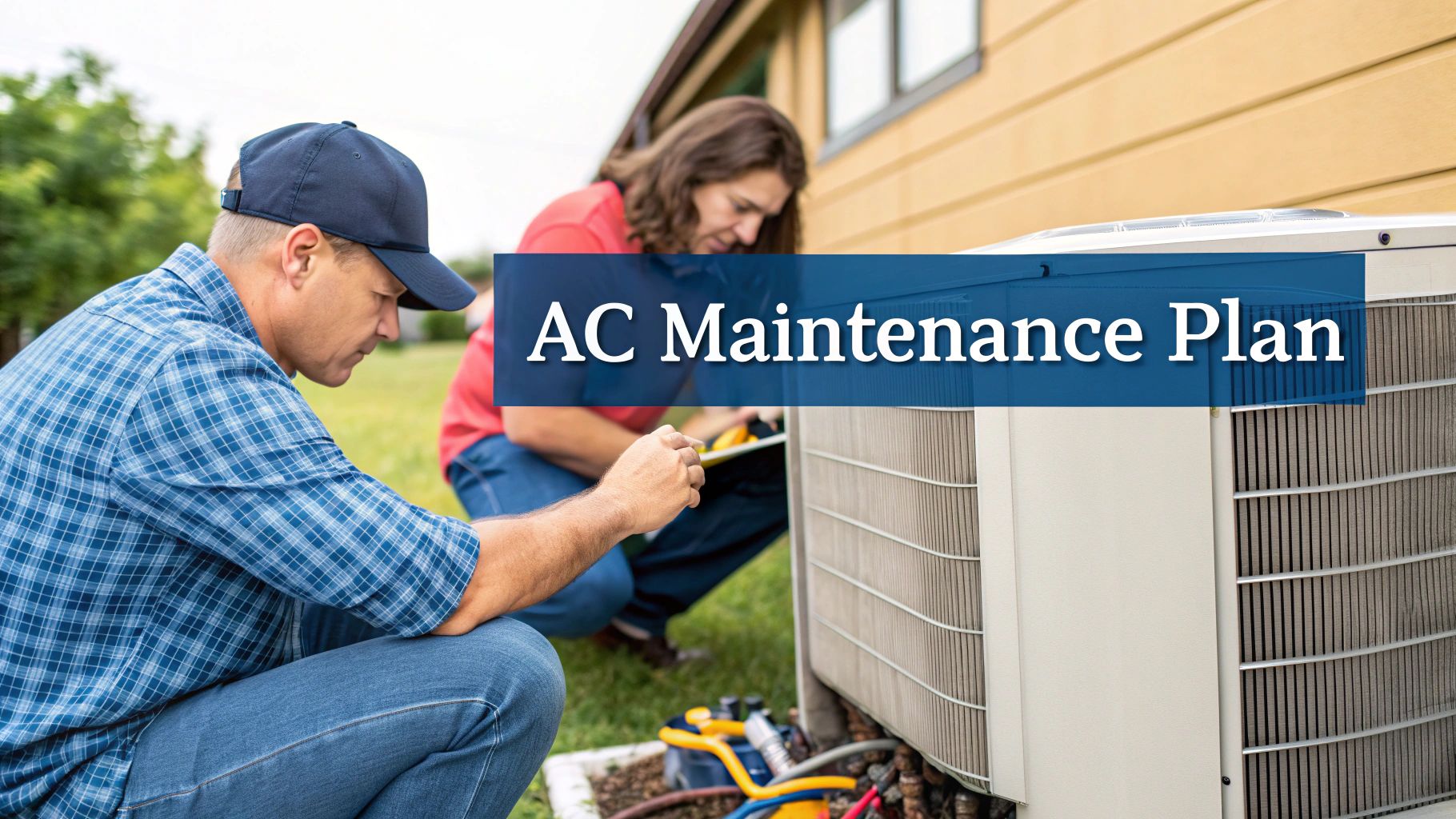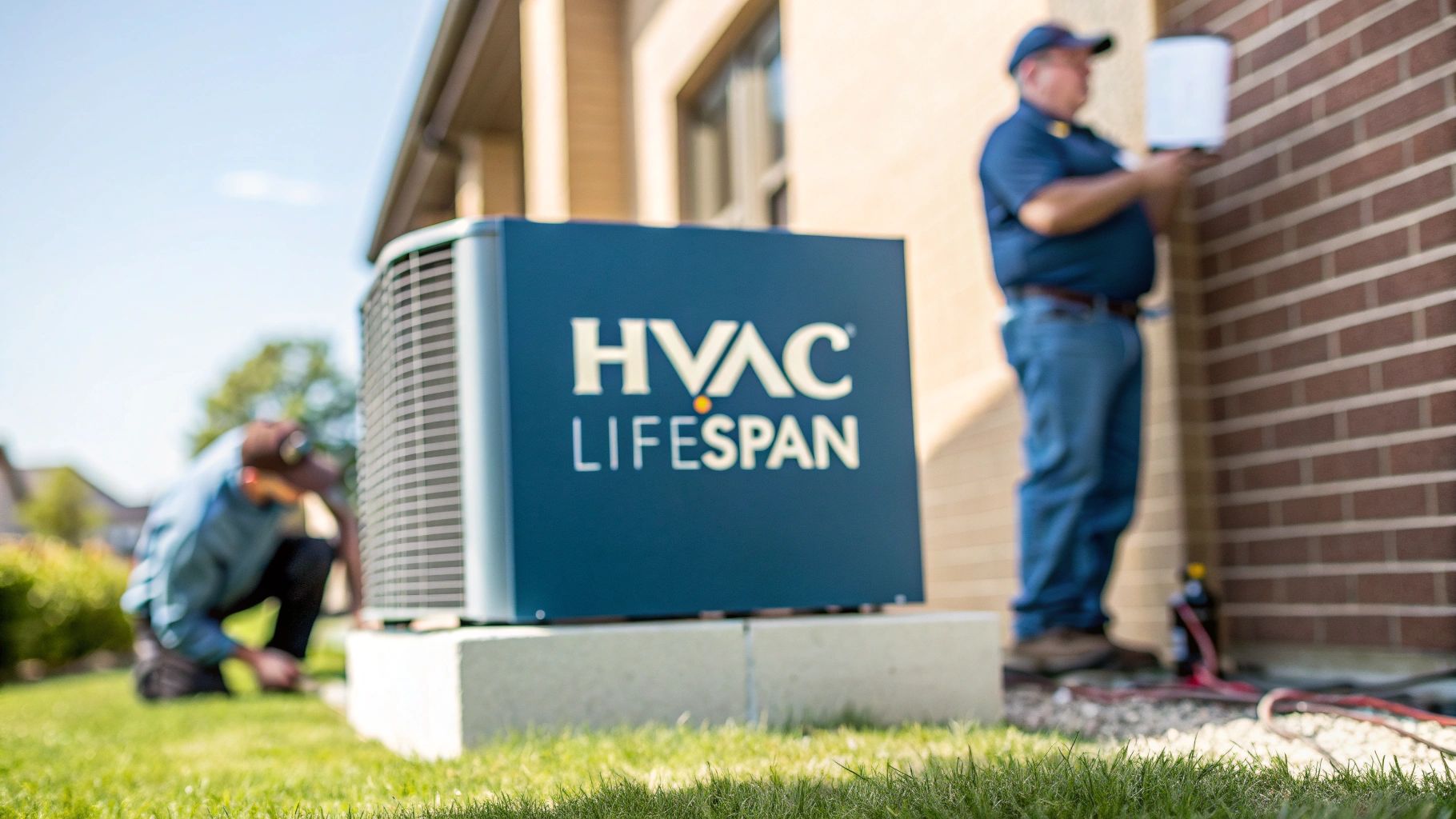So, what's the magic number for your air conditioner? It's a question we all ask when the summer heat starts to climb.
The truth is, there isn’t one perfect temperature. It’s more of a sweet spot, a balance between staying cool and keeping your energy bills in check. For most homes, that "Goldilocks" zone is somewhere between 72°F and 77°F (22°C to 25°C). Think of it as a comfortable starting point—not too cold, not too warm, and just right for your wallet.
Finding Your Perfect AC Temperature
Setting your thermostat is more than just a matter of comfort; it's a strategic move that affects your finances and even your well-being. The real goal is to create an indoor climate that fits your life, whether you're at home during the day, asleep at night, or out of the house. Getting this right means less strain on your HVAC system and lower cooling costs.
Let's not forget the bigger picture. During a serious heatwave, air conditioning isn't just a luxury—it's a critical tool for public health and safety. In 2019 alone, effective home cooling is credited with preventing nearly 200,000 premature deaths during periods of extreme heat. You can explore more on the global impact of cooling over at Our World in Data.
This infographic breaks down the recommended temperatures for different times of the day, making it easy to see where you can save.
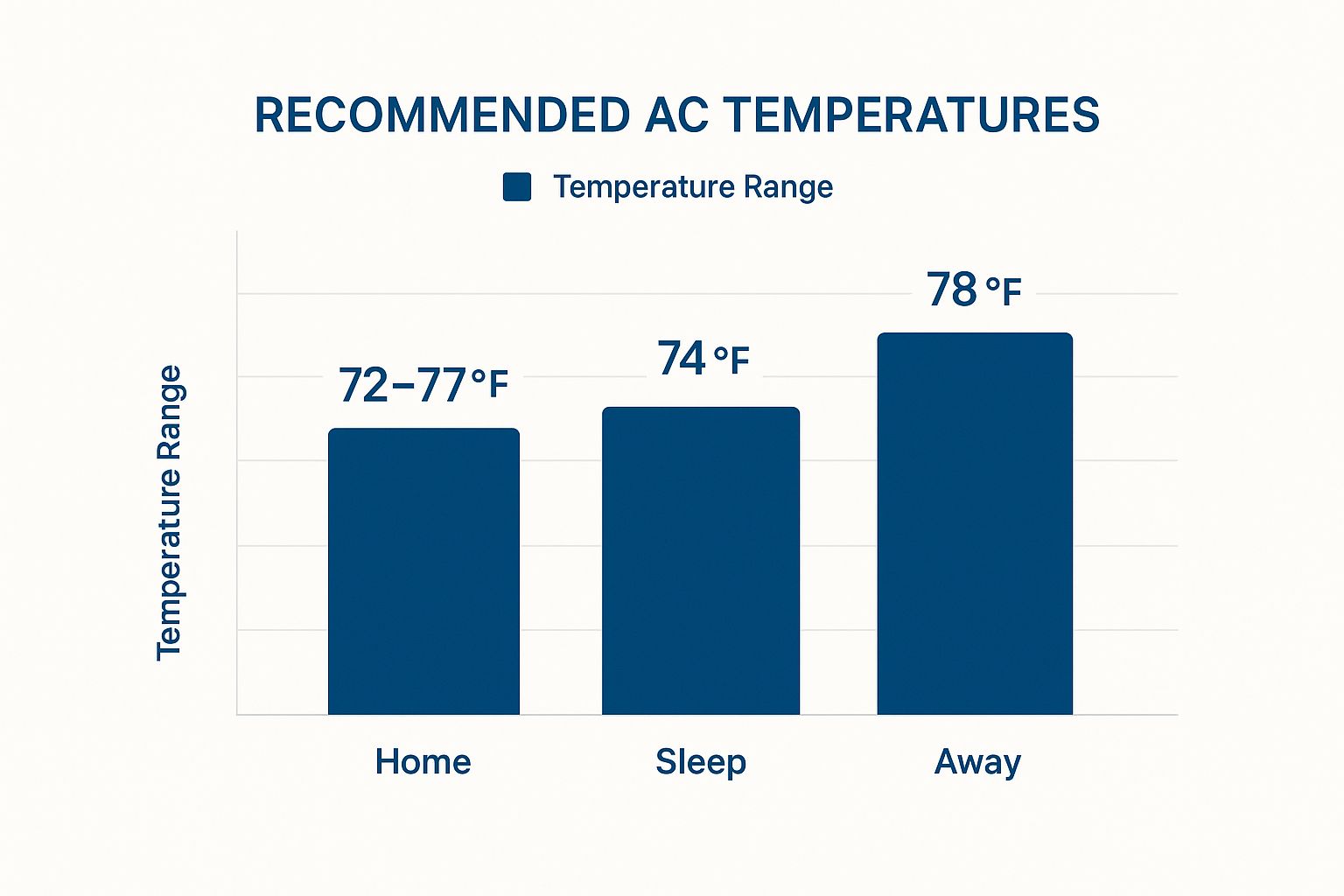
As you can see, simply bumping the thermostat up a few degrees when you’re away or sleeping can make a huge difference in your energy use without you even noticing. It's these small, consistent adjustments that form the foundation of a smart cooling strategy.
Quick Guide to Ideal AC Temperatures
Use this table as a starting point for setting your thermostat to maximize comfort and energy savings throughout the day.
| Situation | Recommended Temperature (°F) | Recommended Temperature (°C) |
|---|---|---|
| When you're home | 72°F – 77°F | 22°C – 25°C |
| When you're away | 80°F – 85°F | 27°C – 29°C |
| While you sleep | 65°F – 70°F | 18°C – 21°C |
Remember, these are just guidelines. The best settings for your home will depend on your personal comfort, local climate, and home's insulation.
By understanding these ranges, you can ditch the "set it and forget it" mentality. Instead, you can start creating a cooling schedule that works smarter, not harder, to keep you comfortable all summer long.
Why 78°F Is the Sweet Spot for Energy Savings
We've all heard the advice from energy experts: set your thermostat to 78°F (25.5°C). But why that specific number? It’s not just a random suggestion. It's a smart setting based on a simple principle of how your air conditioner functions, and it's one of the easiest ways to find a happy medium between comfort and your electric bill.
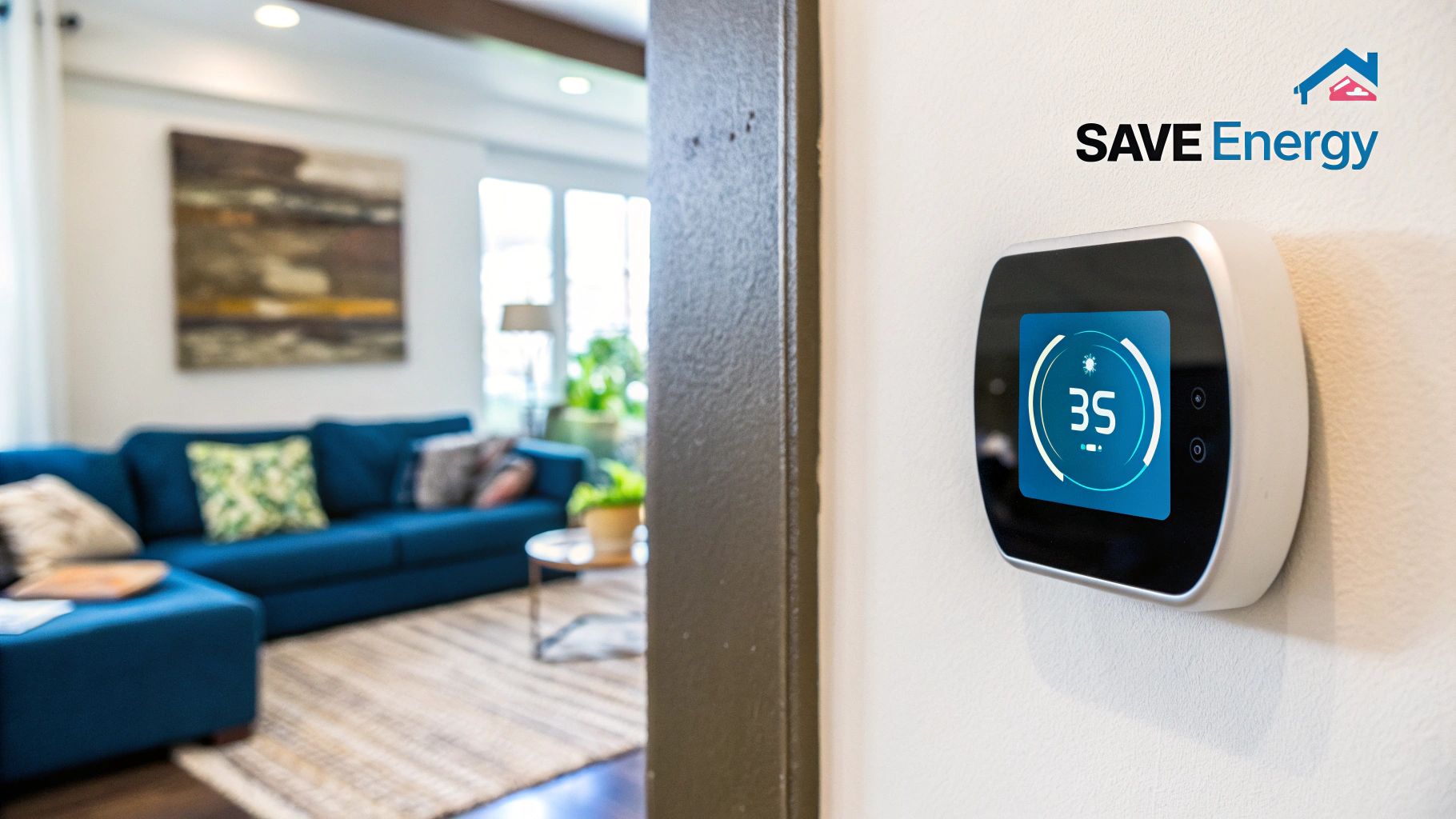
The secret is all about the temperature difference. Your AC unit has to work harder the bigger the gap is between the temperature outside and the temperature you want inside.
Imagine it's a scorching 95°F day. If you crank your thermostat down to a chilly 68°F, you’re forcing your system to battle a massive 27-degree difference. That’s a huge amount of work.
But if you set it to 78°F, that gap shrinks to only 17 degrees. This simple change takes a ton of pressure off your AC’s compressor—the part that uses the most electricity. Less work for the compressor means less energy used and, you guessed it, more money in your pocket.
The Power of a Single Degree
It might not sound like much, but every single degree you raise the temperature makes a real difference. In fact, for every degree you go above 72°F, you can trim up to 3% off your cooling costs.
So, bumping the thermostat from 72°F up to 78°F isn't a small tweak; it can lead to savings of 15-18% or even more over the summer.
Think of it this way: you're turning your AC from a sprinter into a marathon runner. Instead of burning massive energy in short, frantic bursts to drop the temperature, it works steadily and efficiently to maintain a comfortable coolness. This not only saves you money but also reduces wear and tear on the system.
If you'd like to explore this further, take a look at our complete guide on recommended thermostat settings for summer.
Putting Savings into Perspective
Let's quickly recap how this helps your bottom line.
- Less Work, More Savings: A smaller temperature gap means your AC doesn't have to cycle on and off as frequently, which is where it guzzles the most power.
- Small Changes Add Up: Saving a few dollars each day might not seem like a lot, but it results in significant savings over a whole cooling season, especially here in Florida.
At the end of the day, setting your thermostat to 78°F is a practical financial move that doesn’t mean you have to sweat it out. It's the perfect compromise for staying cool while keeping those energy bills from getting out of control.
How Humidity Affects Your AC Settings
Ever wonder why 75°F can feel perfect in a dry, desert climate but absolutely miserable and sticky in a place like Florida? The number on the thermostat is only telling you half the story. The real culprit is humidity—the amount of moisture hanging in the air.
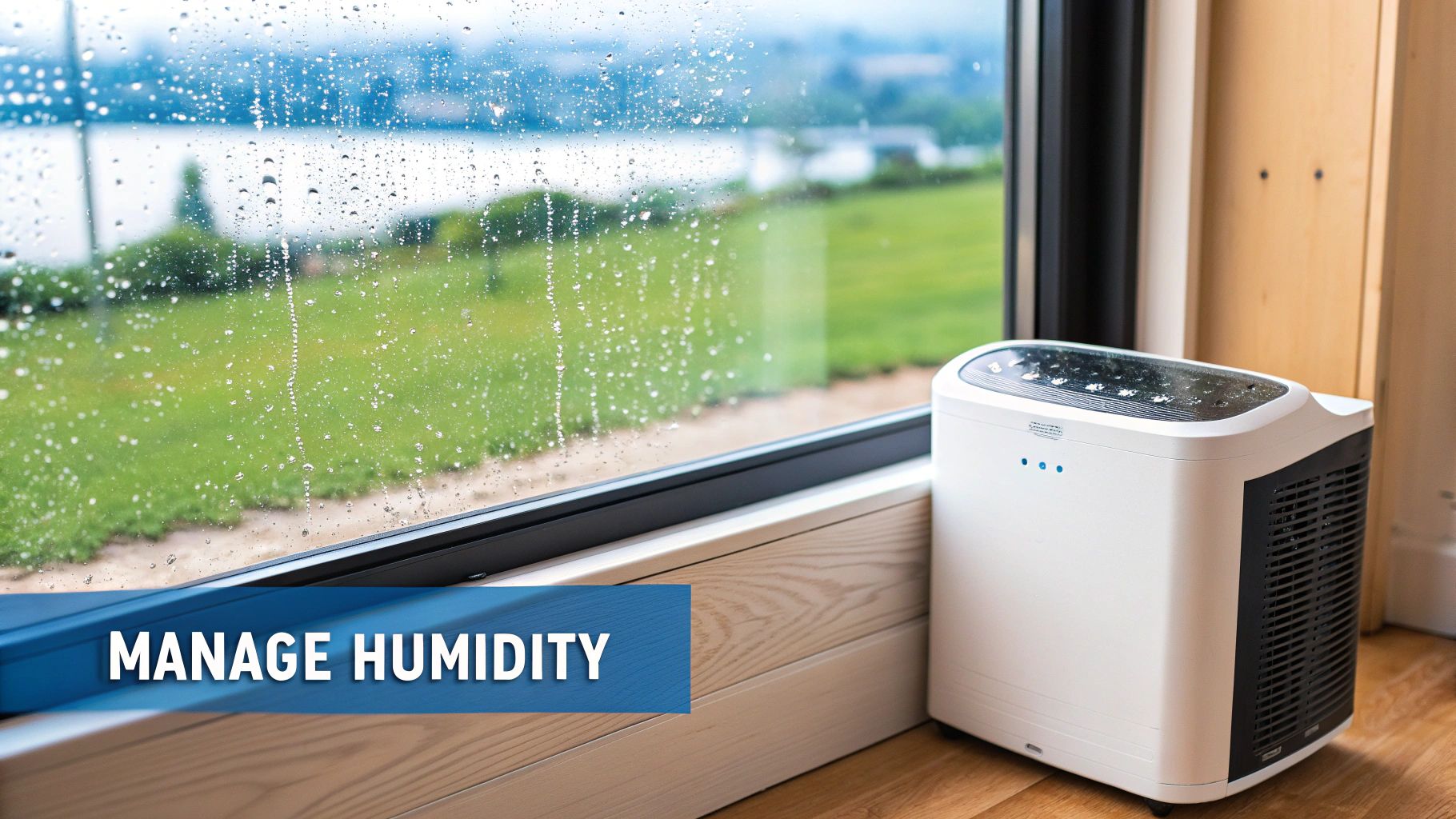
Think about how your body cools itself down: you sweat. As that sweat evaporates from your skin, it takes heat with it, and you feel cooler. But when the air is already thick with moisture, your sweat has nowhere to go. Evaporation slows to a crawl, leaving you feeling much hotter and stickier than the actual temperature would suggest.
This is where your air conditioner plays a dual role. It’s not just a cooling machine; it’s also an incredibly effective dehumidifier. Your AC pulls that warm, muggy air across its cold evaporator coils. This process forces the water vapor to condense out of the air (just like moisture on a cold glass) and drain away, sending cooler, drier air back into your room.
Turning Down Humidity Instead of Temperature
Here’s the secret: if you control the humidity, you can feel comfortable at a higher thermostat setting, which saves a ton of energy. Instead of cranking the AC down to a chilly 72°F on a swampy day, you might feel just as cool and comfortable at 77°F once the humidity is in check.
We always tell clients to aim for an indoor humidity level between 40% and 50%. It’s the sweet spot for comfort and also discourages nasty stuff like mold and dust mites from thriving. Many smart thermostats can even track this for you.
So, how do you get a handle on high humidity? Here are a few practical tips:
- Use Your AC’s "Dry" Mode: Most newer air conditioners have a setting specifically for dehumidifying. It runs the system differently, focusing on pulling moisture from the air rather than just blasting cold.
- Make Sure Your Unit Isn't Too Big: This sounds counterintuitive, but an oversized AC is a huge problem. It cools the space so fast that it shuts off before it gets a chance to run long enough to dehumidify properly, leaving you with that cold, clammy feeling.
- Seal Up Your Home: Check for drafts and air leaks around windows and doors. Every little gap is an open invitation for humid outside air to sneak in and cancel out all your AC's hard work.
Smart Cooling for Different Rooms and Times
Trying to cool your entire home with a single thermostat setting is a fast way to waste money. It’s an old-school approach that just doesn’t make sense. Your home isn’t one big, uniform box; the cooling needs change from the sunny living room to the shady back bedroom, and from midday to midnight.
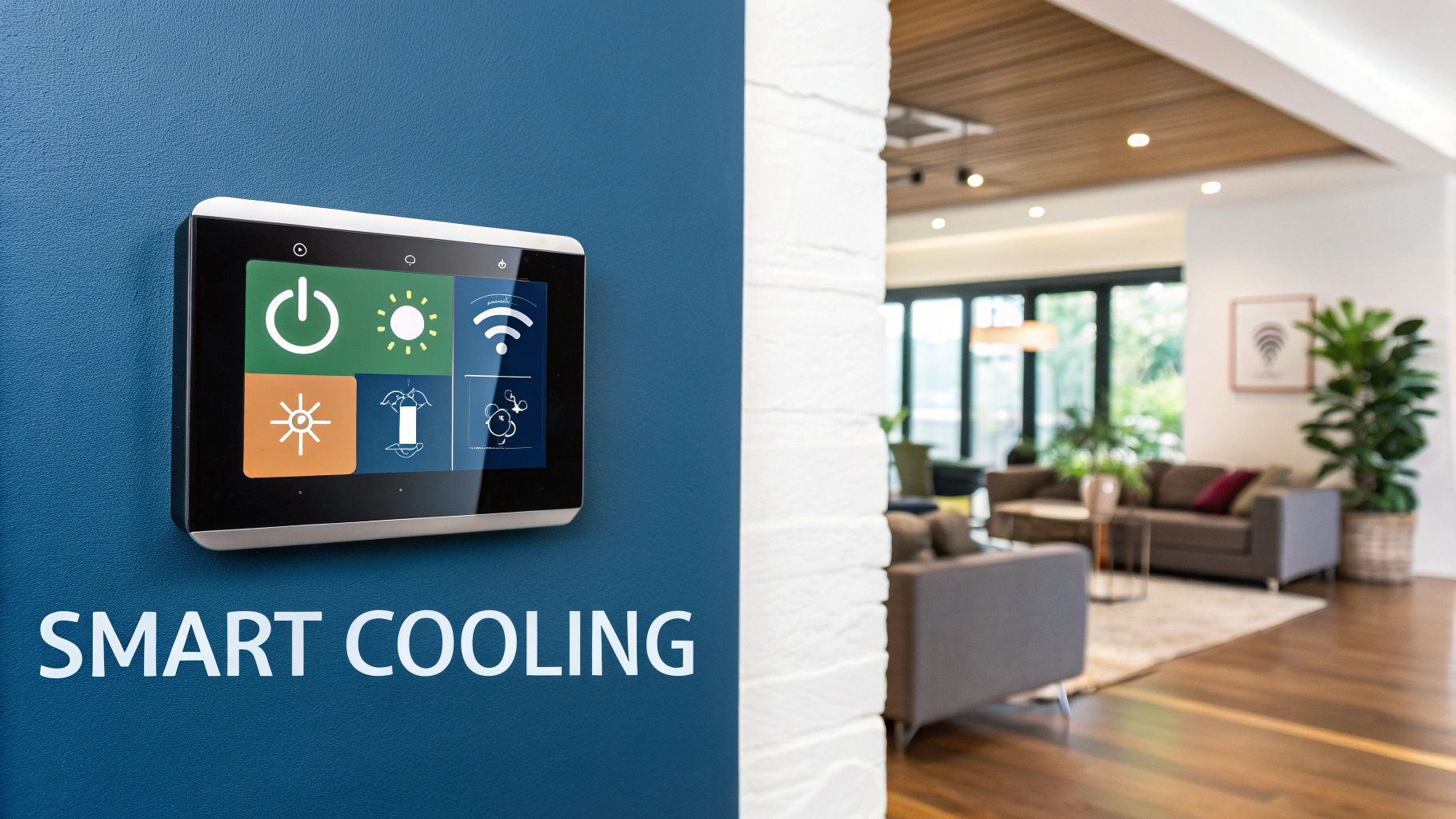
Think about it: the kitchen turns into a sauna when the oven is on, while the guest room sits empty and cool. This is where the concept of zoning comes in. By dividing your home into different climate areas, you can cool only the spaces you’re actually using. You stop paying to chill empty rooms.
To really get this right, modern smart controllers are a game-changer. They give you pinpoint control over each zone from your phone.
Finding the Best Temperature for Sleep
Your AC also needs a different game plan at night. As you sleep, your body’s core temperature naturally dips, so you just don't need the air to be as cold as you might like it during a hot afternoon.
Try nudging the thermostat a few degrees warmer before bed. You’ll slash your energy use without sacrificing comfort. For most people, a temperature around 70-74°F (21-23°C) is perfect for sleeping, especially when you add a ceiling fan into the mix. The fan creates a gentle breeze, making the room feel cooler than the thermostat reading.
This small nightly change is one of the simplest tricks to lower your power bill. Your AC works less, and you still sleep soundly. It’s a win for your bank account and your rest.
Getting smart about your cooling is all about moving past the "one temperature fits all" mindset. It's about being strategic—cooling the right places at the right times. When you customize your settings for different rooms and times of day, you take back control over both your comfort and your energy bills.
The Bigger Picture of Efficient Home Cooling
Setting your thermostat feels like a small, personal decision, but it's one with surprisingly big consequences. As summers get hotter, more and more of us are relying on air conditioning. This puts a huge strain on our power grids and, ironically, contributes to the very energy consumption cycle we're trying to manage. That simple question—"how cold should air conditioning be?"—connects directly to this massive global trend.
This rising demand for cooling isn't just a feeling; it's measured in what experts call cooling degree days (CDD), and that number has been climbing for decades. In fact, since 1970, CDD values have gone up in a staggering 97% of the 240 U.S. locations analyzed. This trend makes one thing clear: making smarter choices about our AC use is more important than ever. You can dig into the full report on these climate patterns over at Climate Central.
Your Role in a Sustainable Future
When you choose to be more efficient with your cooling, you’re doing more than just saving money on your utility bill. You're becoming part of a solution for a more stable energy future.
Every single degree you raise your thermostat makes a real difference. It helps reduce the massive load on the electrical grid, especially during those scorching peak summer hours. When millions of us adopt this simple habit, we can collectively help prevent power grid strain and keep the lights on for everyone.
Adopting efficient cooling habits is one of the most direct ways homeowners can contribute to energy conservation. It's about empowering yourself to make a meaningful difference, one degree at a time.
Of course, your thermostat is just one piece of the puzzle. For an even bigger impact, think about your home's overall energy use. These 8 practical home energy efficiency tips are a great place to start and work perfectly alongside smart AC habits.
Combining a high-efficiency unit with smart daily practices is a powerful one-two punch for change. If you're ready to go even further, we’ve put together a full guide of HVAC energy-saving tips.
Common AC Mistakes That Waste Your Money
https://www.youtube.com/embed/dsid-Ctpi0A
Ever feel like you're throwing money out the window just to stay cool? You might be. Many of us fall into common habits with our air conditioners that unknowingly drive up energy bills and put extra strain on the system.
Let's start with a classic myth: cranking the thermostat way down to a frigid temperature will cool the house faster. It's a tempting thought, but it simply doesn't work that way. Your AC cools at a steady pace, so setting it to 65°F when you want 75°F just forces it to run for hours on end, burning a ton of unnecessary energy to reach that super-low target.
Costly Oversights and Simple Fixes
Another huge money-waster is skipping basic maintenance. When your AC has to struggle to do its job, it guzzles electricity just to keep up.
A perfect example is a dirty air filter. A clogged filter is like forcing your system to breathe through a coffee straw—it restricts airflow and makes everything work harder. Swapping out your filters regularly is one of the easiest and most effective things you can do. If you're curious about your options, we've put together a helpful guide on filters for air vents in your home.
Pro Tip: Keep lamps, TVs, and other heat-producing electronics away from your thermostat. The thermostat's sensor will pick up that nearby heat and think the room is warmer than it is, kicking the AC on when it doesn't need to.
This isn't just about saving a few bucks. The entire AC industry is grappling with how to make systems more efficient. Current testing standards don't always reflect what happens in the real world, especially in sticky, humid climates. Closing this gap is key to improving AC performance and cutting down on emissions. You can read more about the future of next-generation air conditioning on RMI.org.
By steering clear of these simple mistakes, you'll see a real difference in your energy bills, reduce wear and tear on your unit, and ultimately, keep more cash in your wallet this summer.
Common Questions About AC Settings, Answered
Even when you know the basics, real-life questions always pop up as you try to get your home's temperature just right. Let's tackle some of the most common ones with practical, straightforward answers.
Is It Cheaper to Leave the AC on All Day?
This really boils down to how long you’ll be out of the house.
If you're just stepping out for a few hours, it's actually more efficient to bump the thermostat up by 5-8°F (3-4°C) rather than shutting it off completely. This avoids the massive energy surge your AC needs to cool a sweltering house from square one.
But for longer absences, like a full day at work or a weekend trip, your best bet is to set it much higher—think 85°F (29°C)—or just turn it off. That’s where you’ll see the real savings.
What Is the Best Temperature for Sleeping?
Sleep experts often recommend a chilly 60-67°F (15.5-19.5°C), but let's be honest, running your AC that low all night can get pricey.
A smart compromise is to set the thermostat a few degrees cooler than your daytime preference and let a ceiling fan do the rest. The fan creates a gentle breeze that makes you feel much cooler without forcing the AC to work overtime.
Do Ceiling Fans Help an Air Conditioner?
They absolutely do. A ceiling fan can make a room feel up to 4°F cooler, which means you can raise your thermostat by that much and feel just as comfortable. It’s a simple move that can lead to some serious energy savings.
Quick tip: Fans cool people, not rooms. They work by moving air across your skin. So, make a habit of turning them off when you leave a room—otherwise, you're just paying to spin the blades for no reason.
Answering these common questions helps you make smarter decisions every day. You'll stay comfortable, keep your energy bills in check, and put less wear and tear on your HVAC system.
For any HVAC challenges, from emergency repairs to routine maintenance, the certified professionals at Florida Cooling Group are ready to help. Keep your system running perfectly all year long. Contact us today at https://floridacoolinggroup.com for a free estimate.

 (561) 400-2205
(561) 400-2205